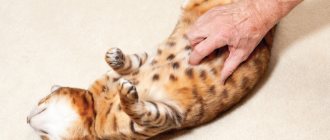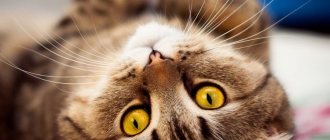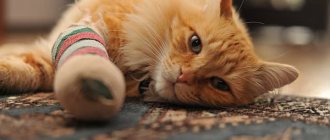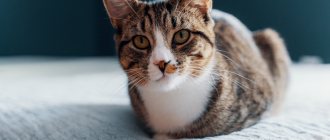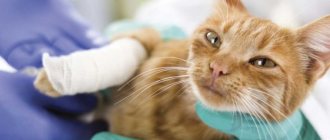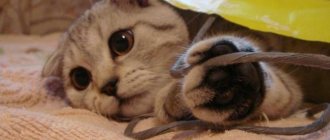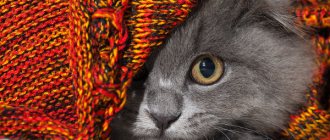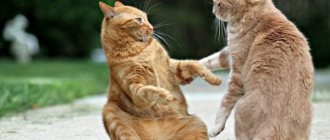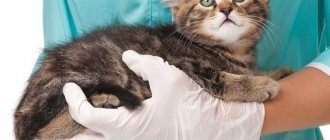Why does a kitten or adult cat knead a person's paws?
Watching an animal, you can see how a cat, climbing onto a person’s lap or stomach, tramples him. This happens for various reasons. If a kitten or adult pet shifts from paw to paw when being stroked, it may be returning to childhood, expressing pleasure from stroking, giving the owner a massage, or establishing ownership.
Back to childhood: recognizing a person as “mother”
If a pet, sitting on the lap or stomach of its mistress or owner, moves its paws, most likely it returns to childhood, when, as a kitten, while feeding, it kneaded its mother’s breasts with its front paws in order to increase the flow of milk to its nipples. At these moments, the kids feel completely safe. Next to their mother, they are full and happy. Growing up, the animal does not lose the need to plunge into childhood and feel protected again.
In moments of unity with the owner, the cat seeks to surround itself with an atmosphere of safety, beginning to knead, as it once did the mother’s breast, his knees or stomach. Experiencing the highest pleasure, pets purr and rumble.
Expression of satisfaction
People to express love for their cats:
- petting pets;
- scratch behind the ear or under the chin;
- speak kindly to animals;
- play;
- treat pets with treats.
Cats, experiencing true pleasure from their owner's attentions, try to express gratitude and love to their owner. The only way they can express their feelings is by moving their paws. This is how the pet “tells” the owner that he loves him, trusts him and enjoys his company.
Establishment of “ownership rights” to the owner or mistress
If a cat crushes a person with its paws, this probably means that this is how he establishes his rights to him. The fact is that on the pads of a cat's paws there are sweat glands, with the help of secretions from which these animals leave odorous marks. The beloved owner becomes an object protected by the cat from those who wish to encroach on him. Being marked as a pet is a special honor, because from now on he will give all the affection and love to the one to whom he has established ownership.
Therapeutic massage session
Cats are not only cute pets, but also healers. They are able to detect illness in the owner. Cats often detect diseases long before humans know about them. When the animals settle down on their owners, they massage them in an attempt to heal them on their own. In search of an answer to the question of why cats lie on their owner’s body and persistently trample it with their paws, it would be a good idea to be examined by a doctor.
There may be no reason to worry, but it still doesn't hurt to get checked. If the diagnosis does not reveal any abnormalities in the functioning of the internal organs, there will be no harm from a cat massage, because by massaging one or another part of the owner’s body, the cat-stomper stimulates blood flow, which has a beneficial effect on the condition of the tissues.
Some people believe that trampling a cat on the owner's body is a sign of troubles related to his health. You should not take this sign seriously, because, as you know, thoughts are material, and if you persistently think about something, it will come true. If a pet often sits in the same place and begins to knead it, this is just a reason to think once again about its health, but not a reason for serious worries.
Therapeutic effect
When cats touch and crush a person with their paws, they share their energy and take away all the negativity. In addition, cat massage has other medicinal properties, due to which animals are used in medicine. Here are just a few facts:
It is worth noting the phenomenal intuition of furry pets, who subtly sense the approach of death and human illness. That is why they often come and lie on a sore spot on the body or near the bed of the dying person.
All these unique skills of pets must be appreciated by showing your attention and care for cats. Only then will they reciprocate and relieve headaches and stress
What are the causes of foot trampling?
There are many theories why a cat tramples with its front paws. Some of them do not stand up to criticism, others can be accepted with reservations. Only the cats themselves probably know the real reason.
The origins of this habit are simple. Anyone who has had a cat feeding kittens knows them very well: here she lies on her side, and the kittens, drinking their mother’s milk, all synchronously crush the food source with their small front paws. By pressing on the cat's mammary gland, they stimulate milk production. So kneading with its paws is one of the first instinctive actions of a kitten. His eyes have not yet opened, he can only eat and sleep, he can hardly reach the nipple, but he is already actively kneading it.
By pressing on the cat's mammary gland, kittens stimulate milk production
In psychology, it is believed that everything comes from childhood. And it's the same with cats. When a kitten suckles from its mother, it not only eats, but also enjoys it and feels protected. Here is the chain: trampled on mom - ate - got pleasure, protection and calmed down - fell asleep. With age, the components “mother” and “ate” are excluded from this chain, but others remain.
Trampling is done by domestic cats, which do not have to think about where to get food, how to find a secluded place to rest, or how to survive. The breed, age, and gender of the animal do not have a significant impact on this habit: these are exclusively individual character traits.
Based on the original source, let's look at the explanations given for the habit of trampling with the front paws.
Desire to play
Absolutely false statement. The animal tramples when it has already played enough and wants to rest peacefully and sleep. Therefore, if you involve your cat in games at this moment, she is unlikely to be happy: she will be offended, leave, or even scratch in indignation. You wouldn't be happy either if you decided to relax with a book, TV, or just take a nap, but you were forced to engage in vigorous activity.
Getting ready for bed
Good explanation. Only this is a consequence, not a cause. That is, cats do not trample because they are getting ready for bed, but simply do it because it feels good. Outdoor cats fall asleep without any trampling.
Desire to mark the owner as property
No. A cat marks you differently. When you return home, saturated with other people's smells, she meets you on the threshold, rubs herself against your legs and thus restores her rights. Cats use their paws to mark territory by strongly scratching the surface (usually trees).
Childhood memories
Animals should not be humanized. The habit of trampling with its paws came from infancy, but the thought is unlikely to enter the cat’s head: “It was so good as a kitten, let me trample with my paws and return to childhood.”
Even if a cat chooses a soft toy as the object of trampling, this does not mean that it remembers itself as a kitten
Stress relief
Animals are stressed. Trampling with your paws relieves tension. If you watch your pet, you will notice that the intensity and duration of such trampling depends on his mood. Sometimes the cat actively stomps around, nervously twitching its tail, and then gradually calms down and relaxes. Thus, this reason is still an explanation for the cat’s habit of trampling its paws, but not the main one.
Treatment and expression of love for the owner
The therapeutic effect of communicating with animals has been proven. The cat occupies one of the first places in pet therapy, but still, trampling with its paws will not cure diseases, although such a unique massage will not bring harm.
A kind of cat massage will not cure you of diseases, but it will not cause harm either.
Cats are, of course, capable of feeling love and affection for their human. But trampling with the front paws is not a pronounced manifestation of these feelings, because the cat tramples not only people, but also bedding, pillows, toys, dogs, and just air. In general, whatever comes under the paw, they trample.
The cat will happily crush the dog with its paws, if the dog allows it, of course.
Pleasure
But this is the main reason. Cats trample because they like it, they get pleasure. Usually, trampling is accompanied by purring, which also indicates that the animal is in complete harmony with the surrounding world. And also, performing actions that bring pleasure is the credo of any domestic cat.
Physiology
From a physiological point of view, there are also explanations for trampling with paws. One of them is this: a cat “massage” is nothing more than a way to mark territory. The thing is that the pads of the domestic “Murzik’s” paws, thanks to the sweat glands and ducts, spread an odorous secretion. In addition, the paws of cats and cats are overly sensitive, they have many nerve endings and receptors. Therefore, with the help of their limbs they receive a considerable amount of information about the world around them.
In addition, some studies have led to the conclusion that the process of pawing and trampling hard provokes the production of endorphins in cats. Which, in turn, helps the animal relax, calm down and even relieve stress. That’s why cats often prepare themselves for sleep in this way.
Photo: Depositphotos
What cats don't trample on humans?
If a cat moves its front paws, sometimes releasing its claws, in professional language this is called a “milk step”. The name refers to a certain fact about kittens: when babies “walk” on their mother's belly, they speed up the flow of milk to the nipples. This association lasts throughout life; kneading with paws is safe and healthy.
Lack of instinct is not due to breed, color or other general factor. Most often, this manifests itself in artificially raised kittens that have lost their mother and were fed from a pipette. It is a little less common for a mother cat to have a lot of milk. In both cases, the little pets did not need to crush the mother’s belly with their paws and get milk for themselves, so they do not show the characteristic instinct at a conscious age.
Kitten crumples a toy with its paws
Indications for massage procedures
The kitten feels the beneficial effects of massage movements from birth; postpartum licking by a cat tones the baby, stimulates processes in the body, and encourages action. Regular massaging of the abdomen is necessary for the baby's digestion. Massage of the tummy and body is mandatory for kittens left without a mother.
Old animals also need additional stress and exercise. Kneading exercises improve the quality and duration of their life, relieve pain, and stimulate the functioning of the kidneys and intestines.
Very active and sedentary animals benefit from massage to normalize muscle tone.
Massage is especially indicated for conditions such as:
- paralysis and paresis after falls and accidents;
- injuries (rehabilitation);
- some congenital and genetic diseases;
- restriction of movements for a long time for various reasons;
- joint dysplasia in large breeds of cats.
Misconceptions
Sometimes “experts” in cat psychology explain their behavior by saying that by massaging something or someone, they receive psychological relief, and endorphins are produced in the body. But, excuse me, when a person experiences pleasure from food, affection or sex, doesn’t he release a hormone of joy? This version puts the cart before the horse and confuses effect and cause. The very act of moving one's paws is caused by pleasant feelings and joy, and not the other way around. With the same success it can be argued that Barsik purrs in order to become happy.
Don’t believe it when, when answering the question why cats knead us with their paws and purr, they tell you about therapeutic massage. Yes, the living warmth of an affectionate cat heals, relieves spasms, even nervous tension. Yes, she often chooses sore spots with elevated temperatures to snuggle and warm up. But Murkas do their “massage” not on the owner’s problem areas, but where it is convenient for them.
Observing cats at home, we notice that they, sensitively sensing and choosing warm places, are completely indifferent to the softness of the sleeping place. Therefore, the hypothesis that they trample the future rookery to make it softer can also not be considered.
An interesting experiment was unintentionally and accidentally carried out in one of the nurseries. A rare breed was being bred, and the mother cat refused to feed her offspring. Six blind newborn kittens were divided into two groups. The three were fed by a diligent laboratory assistant. She wrapped each kitten in a napkin so that it wouldn’t get dirty, picked it up and fed it milk from a pacifier.
The second group was raised by a trainee. He simply placed three bottles sideways on the bottom of the box and went about his business. After two months, a difference in the physical development of the pets became noticeable. Those babies who received food without making any special effort, without moving their paws, without massaging the bottles, turned out to be non-viable. The sad end of the experiment showed the benefit of the reflex. Among other things, it strengthens the kitten’s muscles and develops it physically.
Supernatural version
And of course, one cannot help but mention the very widespread everyday opinion that domestic cats are animal doctors, and cat “massage” can be considered as a method of treatment. This theory is tirelessly proven by many owners of meowing “doctors.” As proof, they point to the fact that their pet is trampling exactly where their owner is in pain.
In contrast to this, we can again recall how cats and cats “treat” in a similar way any other inanimate objects that fall under their paws.
From a scientific point of view
The cat moves its paws over the floor, blanket or person. What does it mean? It is worth noting right away that understanding the process of trampling or pawing will allow you to establish trusting contact with your pet. This will greatly simplify living in an apartment even with the most finicky furry one.
In veterinary practice, a special term will be introduced for moving the paws - “milk step”. What does it mean? The cat consistently marks time, extending and hiding its claws.
Such affection can come from any family member, a stranger, another animal, or even an inanimate object. For example, a favorite soft toy or a blanket on which the pet sleeps. Most often, when a cat kneads its owner's paws, it purrs contentedly.
Childhood experiences
When babies are born, they feed on their mother's milk for a long time. Do you understand where the term “milk step” came from? Kittens press on the cat's belly with their paws so that the nutritional fluid flows faster.
When pranksters grow up, they unconsciously repeat their movements with those people or objects for which they feel special sympathy. Often this is related to safety, because next to the mother cat it was warm and cozy, all the troubles are somewhere far away. The pet often seeks protection and support in this way.
Natural instincts
As you know, cats were not always pets. Their distant ancestors lived in forests. And it’s not so easy to get rid of some habits. Poisonous snakes and other reptiles don’t mind resting in a cat’s den. Its bottom, as a rule, is lined with grass, leaves or rags.
Danger may lurk underneath them. The cat stomps around in the den and crumples the bedding to drive out uninvited guests or check it for sharp sticks.
At home, cats often play, imitating the preparation of a nest. But it is impossible to get rid of instincts. Automatically, the pet checks the bedding for danger.
Mating games
Cats wiggle their paws and purr when they come into heat. Sexual instinct pushes the animal to take active action. Moreover, in a cat this manifests itself at any time, regardless of the beginning of mating games. Even if the male and female are far from each other, they crush their favorite things and soft toys with their paws.
Territory marker
It is believed that cats have sweat glands on their paw pads. The secretions contain a special secret that rivals can easily distinguish. When a cat marks its territory along with sweat, it marks its territory, letting potential opponents know that this place is occupied. If she crushes her owner with her paws, then, for sure, he is also in the direct sphere of influence of the fluffy.
Good mood
The cat subtly senses the mood of the owner. When he is lonely or sad, she tries to keep him company. It’s not enough to just climb onto your lap and allow yourself to be stroked while listening to a cute purr. The cat can roll over on its stomach and play with the owner's hand.
But the main weapon is moving its paws on a person’s back or stomach. Endorphins are produced, which lift the mood not only of the owner, but also of the pet.
Love for the owner
Often a close bond is established between the pet and the person. Sympathy, friendship, affection. This can be called differently, but when a cat wants to express recognition, gratitude for something pleasant, it kneads its owner with its paws. Often, for a pet, a person becomes a substitute mother. The animal becomes very attached and expresses feelings in such an unusual way.
Stomping is a great way for a cat to relieve stress and calm down. Meetings with strangers, other animals, and even an incomprehensible mechanical vacuum cleaner leaves an indelible mark on the pet’s psyche. Touching its paws while purring sweetly is a real pleasure for the animal.
Preparation for sleep
Another long-standing instinct that is intertwined with checking the lair for safety. Cats seem to knead, fluff up a kind of feather bed for sleeping. Although there is an opinion that furry ones can rest in the most unimaginable position, it is much more pleasant to prepare a favorite place by checking it with your paws.
What does treatment include?
The first thing you need to do to help an animal in case of coprostasis is not to feed it for a couple of days. Don’t be afraid, during this time nothing will happen to the animal without food, and this measure will reduce the load on the intestines.
With the drinking regime, the opposite is true - the cat needs to drink a lot. If your pet refuses water, give it water from a syringe without a needle. You can significantly alleviate a cat's suffering from constipation by giving her a massage.
Remember that you should never use a laxative without a veterinarian's prescription. If there is an inflammatory process in the body, taking the drug will only worsen the situation.
Indications and benefits
To solve the problem of constipation, it is recommended to consult a specialist to rule out other diseases of the gastrointestinal tract. Veterinarians may recommend drug treatment with laxatives to restore normal intestinal motility, and prebiotic/probiotic agents to improve microflora. At the same time, the doctor prescribes an enema and massage.
Massaging your cat's belly is a very effective non-drug remedy for constipation. When stroking, peristalsis increases, natural movement of feces occurs through the intestines, and, as a result, the cat begins to go to the toilet normally.
Pros of massage:
- very easy to do at home;
- does not require special skills;
- Suitable for pets of any age and gender;
- so effective that you can do without toxic medications.
However, in some cases, massage for constipation is contraindicated - this point should be clarified with your veterinarian.
Contraindications
Before giving a massage to a cat with constipation, it is worth ruling out intestinal volvulus and colitis. If you ignore the recommendation, instead of alleviating symptoms, you can achieve the opposite effect. For example, if constipation is caused by colitis, the pain will only get worse. With intestinal volvulus, massage is simply useless.
If the animal suffers from dermatological diseases, which include injuries, eczema, burns, etc., the procedure should also be abandoned. If your pet has exhaustion or inflammation of internal organs, massage will only do harm.
You should not give massage to pregnant cats and those who underwent abdominal surgery or pelvic trauma less than six months ago.
Interesting facts about cats purring
There are several facts related to the purring phenomenon:
- There are breeds of cats with a particular loudness of purring.
- The purring skill itself is one of the first to appear; kittens can purr within a couple of days after their birth.
- Babies have a low volume; it is difficult for a person to hear such sounds if they listen carefully. There is an opinion that purring originally appeared in kittens so that the cat could unmistakably find them by sound.
- Some cats don't purr at all. They do not have any health problems; in all other respects they are no different from their counterparts. What this is connected with is still unknown.
- A cat's purring does not always mean that he is feeling good. Cats calm themselves down in a stressful situation, relieve their pain, and purr when they are scared.
- Depending on the situation, a cat's purring sounds in different ranges. Thus, begging for treats is accompanied by loud vibrating sounds; after stress, cats purr quieter and more monotonously.
- Cat owners are 25% less likely to experience circulatory disorders compared to people who have never owned these purring pets.
Frequently asked questions How to learn to purr like a cat? Since humans do not have a special organ (hyoid bones) with which cats purr, it is impossible to accurately reproduce these sounds. Why do cats purr next to humans? Scientists have noticed that the timbre of purring cats next to their owner coincides with the sounds that kittens make near their mother cat. It can be assumed that cats perceive their owners as their mother and continue to communicate with them in the usual way. Why does the cat purr and bite? Most likely, from an excess of feelings. When an animal purrs and lightly bites a person's palm, it expresses its affection for its owner. Sometimes this behavior is an element of the game, this is how the cat demonstrates that she is tired of being pampered and wants to frolic. I like1I don't like
Nellie
How wonderful the full name sounds - Nellie! And it is customary to address a girl in abbreviated form - Nela, Nelia, Nelya, which is pronounced no less beautifully. Let's find out what the name Nelya means?
The origin of the name initially has an ambiguous history. On the one hand, it is known that its roots originate in Greece. And from the language of this country it is translated “bright”. On the other hand, historical fact shows that Nellie is an affectionate diminutive version of the names Eleanor, Elena and Anna. In our area, the name gained popularity in the 18th century thanks to the English nobility of that time. In turn, we approved it as full-fledged and independent, which further contributed to its spread.
Nelly is characterized by unpredictability and emotionality. You never know what to expect from her at one time or another. In an incomprehensible way, a person combines natural modesty with impulsiveness, a picky personality and a creative nature that has a good sense of all facets of art.
Despite her temper, Nellie quickly moves away and knows how to forget an insult, which is why she has very few enemies. He argues a lot, but only to the point. You can safely trust her with any secrets. She is more of a careerist than a homebody. Nelya is more interested in mastering a useful business, profession, and meeting the right people than sitting at the stove and cross-stitching. The name Nelly or Nelya helps its owner realize herself in such professions as teacher, psychologist, artist, doctor, actress.
For family relationships, she is looking for a man equal to herself, with a difficult character, serious and capable of satisfying all her material needs. She is jealous, but keeps herself in control because she prefers calm. This is how she is, Nelya, whose full name is Nelly.
At what age can you massage a cat?
Any kitten begins its life with a massage session - licking a newborn kitten by the mother has a tonic effect and encourages the baby to move, triggers metabolic processes in the body. For the first few weeks of life, the cat massages the kitten's body with its tongue, helping it digest food and empty its intestines.
Older individuals benefit greatly from therapeutic and relaxing therapy techniques. Older animals often suffer from muscle and spinal pain, and a relaxing procedure can help ease or even relieve the pain. A properly performed massage of the cat's abdomen helps remove excess salts through the urethra.
Do not forget that when giving a cat a massage, the owner also benefits from it. Stroking the soft fur helps to calm down and put thoughts in order. It has long been noted that owners of meowing pets are much less likely to suffer from cardiovascular diseases if they are in contact with animals, devoting time to stroking and scratching.
Pets that are so familiar and familiar to us, like cats, actually conceal many secrets and mysteries. A person cannot fully and absolutely reliably explain all the features of their behavior. For example, the ability of cats to “massage” is known and loved by many owners. What actually motivates cats to stomp?
Romantic version
Happy owners of meowing and purring pets value them for the coziness and comfort they bring to their home. Those moments are especially blissful and peaceful when a pet, in a fit of tenderness and devotion, jumps into the owner’s arms and methodically tramples with its front paws. Except, of course, for situations when an animal uses its claws, having forgotten itself and become carried away by the “massage” process.
One of these options refers to the cat's childhood. Some veterinarians and researchers are sure that cats make such movements with their paws from memory, as they once kneaded their cat’s mother’s breasts with their paws during feeding. Little by little, the cats grew up, but the habit remained: now they crush their “human parent.”
For this behavior of cats, the scientists who put forward this version even came up with a special name - “milk step”. By the way, one of the evidence in favor of this version is that some cats, deprived of maternal love and milk in early childhood and artificially fed, do not have the “milk step” reflex. From such cats and cats their owners cannot expect a “massage” with their paws.
Some also believe that such habits are echoes of a former wild life. Before active taming and domestication, felines were wild forest animals. And such a ritual of trampling helped sissy cats to settle down more comfortably for the night on hard grass or in a pile of leaves. This version looks more plausible than equating a cat’s “massage” with a declaration of love to the owner.
Methodology
When performing a massage of the hind legs of cats, it is recommended to combine massage techniques with periodic flexion and extension of the joints.
Helpful advice! During the massage, the animal should be calm and relaxed. However, many cats do not like to have their thighs or paw pads touched - these are particularly sensitive areas. Therefore, during the first few days, you should limit yourself to stroking and lightly rubbing the hind legs, without allowing your cat to show obvious displeasure from the procedure.
The massage procedure is as follows:
- Perform a series of strokes, starting from the back of the animal and ending with the hind legs.
- Take the cat's hind paw in your hand and lightly massage the paw pad and each toe of the hind leg with vibrating movements.
- Knead the muscles and tendons located around the wrist joint, bend and straighten the joint several times.
- Then, using circular rubbing movements, moving towards the base of the paw, reach the hock joint.
- From the hock to the knee joint, alternate the “kneading” and “stroking” techniques; this is the main time-consuming part of the massage.
- Gently bend and straighten the knee joint several times, while simultaneously stretching its muscles.
- Massage your thigh in a circular motion, alternating between stroking and kneading.
- You can perform tapping on the soft tissues of the thigh using bent fingers.
- Finish the paw massage with slow, deep stroking.
- Massage the other paw in the same way.
- Pet your cat and praise him.
If you perform the massage correctly, your pet will receive not only benefits from this procedure, but also pleasure. When touched by the owner's hands, the cat will purr, close its eyes and press its body to the hands.
Massage technique for a cat on video:
- Massage for cats and cats during constipation
- How and why to give a cat a bladder massage
The highest measure of affection
The cat sits comfortably on the owner's chest or on his lap. Then she moves her paws, extending her claws a little. Scientists have amazed all lovers of these pets. It turns out that in this way the furry ones show complete contentment and their love. This habit appears in cats from a young age.
The kitten settles comfortably near its mother’s belly, pressing its paws on the nipple as it drinks milk. Naturally, the pet does not at all strive to provoke the release of goodies from its owner. However, eating in any animal has always been associated with pleasure and joy, which is why a childish reflex appears. After all, in a way, the cat owner replaces the furry animal’s mother.
If a cat and a person interact, it is beneficial for both parties. Zoologists have proven that a cat evokes only positive emotions in humans. If an animal is nearby, it helps to cope with various kinds of stress and negative well-being. In addition, stomping your paws on the stomach will help cope with diseases of the nerves and heart.
Under no circumstances should you drive away a cat when it is crushing you with its paws. The pet will not be able to understand why he was driven away, because he confessed his love to his beloved owner. And if the cat gets so carried away that he lets out his claws and starts scratching your stomach or neck, you can distract your pet with some kind of toy or a blanket.
What should and should not be done?
Touching and kneading the owner with its paws is a natural behavior for every furry pet. You can’t blame him for this, just like:
- Punish;
- Use physical force;
- Limit your attention.
If a cat tramples with its paws and at the same time releases claws that scratch the skin or tear clothes, the owners can use the following techniques:
- It is necessary to trim the nails, but not too short;
- You can pet your pet;
- You can place a thick blanket under the cat's paws;
- It is worth lightly pressing on the front paws, which will force the pet to remove its claws;
- You can distract your pet's attention by showing his favorite toy;
- It is recommended to lay the cat on its side, stroking its head.
Massaging and purring a cat is the best manifestation of his attention and love. If you decide to punish your pet for this, you risk ruining your relationship with him forever and causing his aggression.
Probable Causes
Experts in the field of animal psychology identify several reasons why cats knead their paws. This ritual has the following explanations and theories:
Memory of childhood. A newborn baby, feeding on mother's milk, kneads his mother's mammary glands with his paws
This massage stimulates milk production, which is important when the cat has more than one baby. At the same time, feeding itself causes positive emotions in the pet.
Having matured, many kittens perceive their caring owners as their cat mother. Having transferred their pleasant childhood memories to humans, young animals settle down next to their beloved owner and begin to touch their paws.
It is for this reason that cat breeders call this ritual the “milk step.” Owners often notice that the kitten not only wiggles its paws, but also purrs contentedly and even drools with pleasure. This theory is supported by the fact that artificially fed pets are not capable of the “milk step”.
One of the reasons why cats paw is their natural instincts. Being once wild predators, animals carefully prepared places for rest and overnight: they trampled down hard grass, making the nest cozy and soft. In the wild, representatives of the cat family use grass and leaves to make a nest. To make your sleeping area comfortable and safe, it needs to be put in order. The most convenient way to do this is to crush objects with your paws.
The desire to equip one’s territory, a place to rest and sleep, is also characteristic of modern domestic couch potatoes. And although most pets live in comfortable conditions, nevertheless, they have not lost the ancient instinct of their wild ancestors. In addition, the cat often crushes soft objects with its paws, arranging a nest for birth and future offspring. Often this behavior is a sign of impending labor.
Hunting instinct. Some experts believe that domestic cats knead a soft surface, obeying the ancient hunting instinct. Predators by nature, pets have not lost the ancient skills of this skill. Their wild counterparts, before jumping on the prey, crush the surface with their paws, testing it for stability and hardness.
It is important for a predator that at a crucial moment a branch does not snap under its paw. Fluffy couch potatoes have not lost their natural instincts, but they do not always use them for their intended purpose.
Territorial version. Some zoologists are inclined to believe that the reason why cats crush their owners' paws is their desire to mark their territory. There are specific glands on the pads of cats' paws, with the help of which they identify their possessions and territory.
Considering its beloved owner to be its property, the animal leaves its scent on his body, making it clear to other individuals that they can no longer have the right to the owner’s attention. Thus, the ritual serves as a kind of marker to mark one’s property and possessions.
Psychological release. The psycho-emotional tension or stress accumulated by the pet requires release. Some animal psychologists, not without reason, believe that the reason why cats knead the blanket with their paws is self-soothing. At the same time, the animal practically disconnects from the outside world and focuses on its internal sensations. Monotonous paw movements and purring help calm the pet.
This point of view is supported by the fact that during the “milk step” the cat’s body produces endorphins - specific substances, hormones of happiness. They reduce anxiety and fear in pets.
Other factors. Experienced breeders believe that the reason for the cat ritual is a high degree of trust and love for its owner. Many cat fans believe that animals perform such a ritual for a healing purpose - they treat their owner from various ailments, taking away negative energy.
Another reason why cats massage their paws is sexual behavior. As a rule, in the spring, with increasing daylight hours, the production of sex hormones increases, which in some individuals is accompanied by a “milk step”.
The variety of theories, versions and guesses regarding a peculiar ritual inherent only to representatives of the feline family once again testifies to the mystery and enigma of domestic cats.
We recommend reading about why cats sleep at their owner's feet. You will learn about the reasons for this behavior, the characteristics of cat sleep, favorite places to sleep. And more about how to remove a cat from a tree yourself and with the help of special services.
Indications for the procedure
Cats normally defecate once a day. Animals over 7 years old go to the toilet approximately once every 2 days. If there is no bowel movement for more than 3 days, the cat is constipated.
Typical symptoms:
- restless behavior;
- lethargy;
- refusal of food;
- bloating.
When constipated, the pet sits in the litter box and strains, but does not defecate. Sometimes dry and hard feces are passed in small quantities. However, this does not solve the problem.
You can help your pet yourself. Massage during constipation improves the functioning of the gastrointestinal tract, increases the elasticity of the walls and enhances intestinal motility, which stimulates the release of feces.
Important. If measures are not taken, the body will no longer cope with decay products, the load on the heart will increase, and the functioning of the liver and kidneys will worsen. All this leads to serious complications, including death.
All this leads to serious complications, including death.
Massage is performed for the following problems:
- Constipation due to stress. If the cause is eliminated in a timely manner, massage will normalize bowel movements without the use of medications.
- Chronic constipation. Stool disorders will appear much less frequently. It will be possible to reduce the dosage of medications or stop taking them altogether.
- Constipation in a cat due to a sedentary lifestyle. Typically seen in older animals who become less active.
- Constipation due to changes in diet or poor diet. Difficulty defecating is caused by insufficient fiber intake or a sudden change in food.
- Constipation in obesity. In overweight cats, metabolic processes slow down, which leads to the appearance of dry feces and untimely bowel movements.
It is useful to do massage after birth if the cat has no complications and is in satisfactory condition. The procedure speeds up the recovery of the body and prevents the occurrence of mastitis and other diseases.
If, in addition to constipation, your cat has a fever (above 39.5°C) and vomiting, you should immediately contact your veterinarian. Most likely, she has some serious illness.
Massage is a safe and effective procedure that acts in several directions at once:
- strengthens and tones the abdominal muscles;
- stimulates the movement of feces;
- activates lymph flow and blood circulation;
- relieves pain;
- eliminates spasms;
- reduces gas formation.
Massage is useful even if there is no constipation. It helps to establish a trusting relationship with your pet. Tactile contact brings people closer together and relaxes them. And if you follow the technique, the procedure will be pleasant for the cat.
Massage is used to treat constipation when the cat’s general condition does not cause concern. The procedure is not carried out:
- for dermatological diseases and skin damage on the abdomen;
- inflammatory diseases of the musculoskeletal system;
- colitis, gastritis and other gastrointestinal diseases;
- spasms of the large intestine;
- suspected benign or malignant tumor;
- intestinal hernia or tumor;
- volvulus;
- exhaustion of the cat’s body;
- blockage of the intestine by a foreign body;
- during pregnancy.
After abdominal operations (caesarean section, sterilization), massage is not performed for 6 months.
Constipation sometimes occurs in cats that have broken their pelvic bones. Improper fusion of bones or adhesions leads to defecation problems. To understand the cause, an x-ray is first taken.
Belly massage is also recommended for kittens and older cats. However, it is better to consult a veterinarian first. Excessive or awkward movements can injure your pet.
Host actions
Ardent cat lovers are sympathetic to the instincts of their pets. People who meet their mustachioed pet for the first time may be dissatisfied with the manifestation of her feelings. Cats crush their owners with their paws, not always controlling their claws.
This habit leaves unpleasant marks on a person’s delicate skin. The following recommendations will help prevent this:
- Sharp, rude pulling of the animal from the “crushing” ritual is not allowed. Whatever the reason for this habit, the cat thus shows tender feelings towards its person. If the owner cannot understand her (he will scream and swear), she will stop trusting him. The consequence may be ragged corners due to the stress of the animal.
- For such purposes, it is better to have a thick blanket on hand that can be placed on your lap. It will save the owner's skin from claws without compromising the pet's instinct.
- If there is nothing at hand, the cat must be carefully distracted by playing or moved to another place.
- You can lightly press your pet with your palm and stroke it. In the “lying down” position, it will not be convenient for her to move either her hind or front paws.
Should I be scolded for such behavior?
Understanding why cats knead the blanket with their paws, the owner should under no circumstances punish the pet for displaying natural instincts. You should be understanding of the complex and peculiar behavior of the cat. Negative emotions, irritating intonations, and being thrown off your knees during the “milk step” can lead to stress and the development of a negative psycho-emotional state. The animal will stop trusting the person and will withdraw from communication with him.
The owner may not like the fact that the cat crumples his body due to the fact that some individuals can release their claws and injure him. In this case, it is advisable to keep a thick towel or small blanket nearby to lay on your lap. This will protect the owner from injury if the cat releases its claws.
You can stop the unwanted action by lightly pressing the cat against a soft surface. She will settle down and calm down. Stroking and gentle intonations will calm the pet, and it will stop kneading the owner’s paws.
The unusual behavior of domestic cats in the form of trampling in one place has a variety of reasons. Most often, a kind of ritual is associated with the natural instincts and psycho-emotional state of the animal. An attentive and affectionate attitude towards the pet at this moment is the only thing required from a loving owner.
Cats are amazing creatures. Despite the fact that they have lived next to humans for many millennia, their behavior sometimes raises questions in us. Many owners of such pets are interested in why cats trample.
What is the reason for these animals moving their paws? What does this behavior mean? How should you behave when a cat crushes its owner or the sofa with its paws?
[custom_ads_shortcode3]
Therapeutic effect
When cats touch and crush a person with their paws, they share their energy and take away all the negativity. In addition, cat massage has other medicinal properties, due to which animals are used in medicine. Here are just a few facts:
It is worth noting the phenomenal intuition of furry pets, who subtly sense the approach of death and human illness. That is why they often come and lie on a sore spot on the body or near the bed of the dying person.
All these unique skills of pets must be appreciated by showing your attention and care for cats. Only then will they reciprocate and relieve headaches and stress
